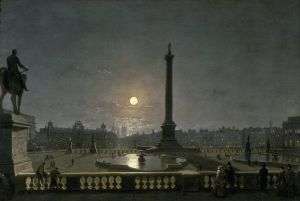Northumberland House
Coordinates: 51°30′27″N 0°7′36″W / 51.50750°N 0.12667°W

Northumberland House (also known as Suffolk House when owned by the Earls of Suffolk) was a large Jacobean townhouse in London, which was so called because for most of its history it was the London residence of the Percy family, who were the Earls and later Dukes of Northumberland, and one of England's richest and most prominent aristocratic dynasties for many centuries. It stood at the far western end of the Strand from around 1605 until demolished in 1874. In its later years it overlooked Trafalgar Square.
Background
In the 16th century the Strand, which connects the City of London with the royal centre of Westminster, was lined with the mansions of some of England's richest prelates and noblemen. Most of the grandest houses were on the southern side of the road and had gardens stretching down to the River Thames.
Construction
In around 1605 Henry Howard, 1st Earl of Northampton cleared a site at Charing Cross[1] on the site of a convent[2] and built himself a mansion, which was at first known as Northampton House. The Strand facade was 162 feet (49 m) wide and the depth of the house was marginally greater. It had a single central courtyard and turrets in each corner.
The layout reflected medieval traditions, with a great hall as the principal room, and separate apartments for members of the household, who would still at that time have included gentlemen attendants such as Jassintour Rozea, French Master Chef 1748. Many of these apartments were reached from external doors in the courtyard in the manner still seen at Oxbridge colleges. The exterior was embellished with classical ornament in the loose way of ambitious Jacobean buildings. The most striking external feature was the elaborate four storey carved stone gateway fronting the Strand. The garden was 160 feet (49 m) wide and over 300 feet (91 m) long, but unlike those of the neighbouring mansions to the east it did not reach all the way down to the river.
Seventeenth & Eighteenth Centuries
The house passed from Lord Northampton to the Earls of Suffolk, who were another branch of the powerful Howard family headed by the Dukes of Norfolk, and in the 1640s it was sold to the Earl of Northumberland at the discounted price of £15,000 as part of the marriage settlement when he married a Howard.
Regular alterations were made over the next two centuries in response to changes in fashion and to make the layout more convenient for the lifestyle of the day. John Webb was employed from 1657 to 1660 to relocate the family's living accommodation from the Strand front to the garden front. In the 1740s and 1750s the Strand front was largely reconstructed and two wings were added which projected from the ends of the garden front at right angles. These were over 100 feet (30 m) long and contained a ballroom and a picture gallery, the latter itself 106 feet (32 m) long. The style of the new interiors was late palladian and the architects were Daniel Garrett until his death in 1753, and then the better known James Paine. In the mid-1760s Robert Mylne was employed to reface the courtyard in stone, and he may also have been responsible for extensions to the two garden wings which were made at this time. In the 1770s Robert Adam was commissioned to redecorate the state rooms on the garden front. The Glass Drawing Room at Northumberland House was one of his most celebrated interiors. Part of the Strand front had to be rebuilt after a fire in 1780.
Nineteenth century
In 1819 Thomas Cundy rebuilt the garden front five feet further south as the wall was unstable, and in 1824 he added a new main staircase.

By the mid 19th century all of the other mansions on the Strand had been demolished. The area was largely commercial and was not a fashionable place to live. However the Duke of Northumberland of the day was reluctant to leave his ancestral home, despite pressure from the Metropolitan Board of Works, which wished to build a road through the site to connect to the new roads along the Embankment. After a fire, which caused substantial damage, the Duke eventually accepted an offer of £500,000 in 1866 (which translates to approximately £39,220,000 in 2012). Northumberland House was demolished and Northumberland Avenue was constructed in its place.
Northumberland Avenue
One of the largest buildings on Northumberland Avenue was a 500 bedroom hotel called the Victoria Hotel. During the Second World War, it was taken over by the Government for use by the Ministry of Defence and renamed Northumberland House. This "new" Northumberland House was left empty for several years until it was purchased by the Welcome Trust.
Remains
An archway from Northumberland House, designed by William Kent was sold for the entrance to the garden of Tudor House, which formerly stood in Bromley-by-Bow. This was moved in 1998, to form the principal entrance to the Bromley by Bow Centre.
See also
- Alnwick Castle - the Percy family's main seat.
- List of demolished buildings and structures in London
- Syon House - the Percy family's west London residence.
Notes, references and sources
- Notes and references
- ↑ The site was the eastern portion of the former property of the Chapel and Hospital of St Mary Rounceval.
- ↑ Hibbert, Christopher; Ben Weinreb; John Keay; Julia Keay. (2010). The London Encyclopaedia. London: Pan Macmillan. p. 593. ISBN 978-0-230-73878-2.
- Sources
- London's Mansions David Pearce (BT Batsford Ltd, 1986) ISBN 0-7134-8702-X
External links
| Wikimedia Commons has media related to Northumberland House. |
- Northumberland House at the Survey of London online
- Northumberland House and its associations - section of Old and New London Volume 3 (1878)
- http://www.imperial-london.me.uk/northumberland-house.php
